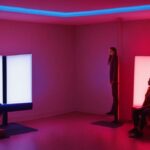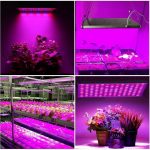Last Updated on 12 months by Francis
Contents
The Basics of Light Therapy
Light therapy is a non-invasive treatment that uses specific wavelengths of light to improve mood, sleep, and skin health. It is often referred to as phototherapy or bright light therapy. The therapy involves exposing the skin to specific wavelengths of light using a light box or other devices.
How Does Light Therapy Work?
Light therapy works by stimulating the body’s natural healing mechanisms. It triggers the production of serotonin, a hormone that helps regulate mood and sleep. Additionally, it can increase the production of melatonin, a hormone that helps regulate sleep patterns.
Types of Light Therapy
There are several types of light therapies used to treat different conditions. These include:
- Blue Light Therapy: Used to treat acne and other skin conditions.
- Red Light Therapy: Used to promote wound healing and reduce inflammation.
- Green Light Therapy: Used to treat hyperpigmentation and other skin conditions.
- White Light Therapy: Used to treat seasonal affective disorder (SAD) and other mood disorders.
Conditions Treated with Light Therapy
Seasonal Affective Disorder (SAD)
SAD is a type of depression that typically affects people during the winter months when there is less sunlight. Light therapy is an effective treatment for SAD, and it involves exposing the skin to bright light for a specific amount of time each day. The therapy can help regulate mood, reduce fatigue, and improve overall well-being.
Acne
Acne is a common skin condition that affects millions of people worldwide. Light therapy, particularly blue light therapy, is an effective treatment for acne. It works by killing the bacteria that cause acne and reducing inflammation in the skin.
Psoriasis
Psoriasis is a chronic autoimmune condition that affects the skin. Light therapy, particularly ultraviolet (UV) light therapy, is an effective treatment for psoriasis. It works by suppressing the immune system and reducing inflammation in the skin.
Pain Relief
Light therapy is an effective treatment for chronic pain conditions such as arthritis, fibromyalgia, and back pain. It works by reducing inflammation and promoting the production of endorphins, the body’s natural painkillers.
Sleep Disorders
Light therapy is an effective treatment for sleep disorders such as insomnia and circadian rhythm disorders. It works by regulating the production of melatonin, a hormone that helps regulate sleep patterns.
Risks and Side Effects
Risks
The risks associated with light therapy are minimal, but they include:
- Eye damage: Exposure to bright light can damage the eyes, so it is essential to wear protective eyewear during treatment.
- Skin damage: Exposure to UV light can cause skin damage and increase the risk of skin cancer.
- Mania: In rare cases, light therapy can trigger manic episodes in people with bipolar disorder.
Side Effects
The side effects of light therapy are usually mild and include:
- Headache
- Eyestrain
- Nausea
- Irritability
Conclusion
Light therapy is a safe and effective treatment for a wide range of conditions, including SAD, acne, psoriasis, chronic pain, and sleep disorders. It works by stimulating the body’s natural healing mechanisms and is associated with minimal risks and side effects. If you are considering light therapy, it is essential to talk to your healthcare provider to determine if it is a suitable treatment option for you.# What is Light Therapy Used to Treat?
Light therapy, also known as phototherapy, is a treatment method that uses certain wavelengths of light to address various health conditions. This therapy has been around for centuries and is widely used today to treat a variety of issues, including seasonal affective disorder, depression, sleep disorders, skin conditions, and pain management. Light therapy involves exposure to bright, artificial light that simulates natural sunlight in order to regulate circadian rhythm and promote healing in the body. In this article, we will explore the various applications of light therapy and how it can be used to treat a range of health conditions.
The Basics of Light Therapy
Light therapy is a non-invasive treatment that uses specific wavelengths of light to improve mood, sleep, and skin health. It is often referred to as phototherapy or bright light therapy. The therapy involves exposing the skin to specific wavelengths of light using a light box or other devices. The wavelength of light used in light therapy ranges between 400 to 700 nanometers (nm), which is between visible violet and red light.
How Does Light Therapy Work?
Light therapy works by stimulating the body’s natural healing mechanisms. It triggers the production of serotonin, a hormone that helps regulate mood and sleep. Additionally, it can increase the production of melatonin, a hormone that helps regulate sleep patterns. Exposure to bright light can also affect the body’s circadian rhythm, which is the internal 24-hour clock that regulates sleep-wake cycles, hormone production, and other physiological processes.
Types of Light Therapy
Conditions Treated with Light Therapy
Seasonal Affective Disorder (SAD)
SAD is a type of depression that typically affects people during the winter months when there is less sunlight. Light therapy is an effective treatment for SAD, and it involves exposing the skin to bright light for a specific amount of time each day. The therapy can help regulate mood, reduce fatigue, and improve overall well-being. Light therapy for SAD is typically done using a light box that is designed to mimic the natural outdoor light.
Acne
Acne is a common skin condition that affects millions of people worldwide. Light therapy, particularly blue light therapy, is an effective treatment for acne. It works by killing the bacteria that cause acne and reducing inflammation in the skin. Blue light therapy is typically done using a light-emitting diode (LED) device that emits blue light at a specific wavelength.
Psoriasis
Psoriasis is a chronic autoimmune condition that affects the skin. Light therapy, particularly ultraviolet (UV) light therapy, is an effective treatment for psoriasis. It works by suppressing the immune system and reducing inflammation in the skin. UV light therapy is typically done in a healthcare setting, and the patient is exposed to UV light for a specific amount of time each session.
Pain Relief
Light therapy is an effective treatment for chronic pain conditions such as arthritis, fibromyalgia, and back pain. It works by reducing inflammation and promoting the production of endorphins, the body’s natural painkillers. Red light therapy is typically used for pain relief and is done using an LED device that emits red light at a specific wavelength.
Sleep Disorders
Light therapy is an effective treatment for sleep disorders such as insomnia and circadian rhythm disorders. It works by regulating the production of melatonin, a hormone that helps regulate sleep patterns. Light therapy for sleep disorders is typically done using a light box that emits bright light at a specific wavelength.
Skin Rejuvenation
Light therapy is also used for skin rejuvenation and has been shown to improve the appearance of fine lines, wrinkles, and age spots. Red light therapy and a combination of red and blue light therapy are typically used for skin rejuvenation. Light therapy for skin rejuvenation is typically done using an LED device that emits red and/or blue light at specific wavelengths.
Risks and Side Effects
Risks
Side Effects
FAQs – What is light therapy used to treat?
What is light therapy?
Light therapy, also known as phototherapy, is a therapeutic technique that uses various types of light to treat a range of medical conditions. It involves exposure to specific wavelengths of light that can either be delivered through light boxes, lamps, or wearable devices.
What medical conditions can be treated with light therapy?
Light therapy has been found to be effective in treating a range of medical conditions, including seasonal affective disorder (SAD), depression, sleep disorders, skin conditions such as psoriasis and eczema, acne, and some types of cancer.
Different types of light therapy work in different ways. For example, light therapy for depression works by regulating the circadian rhythm, the body’s natural clock, which can be disrupted in people suffering from depression. Light therapy for skin conditions works by reducing inflammation and accelerating the healing process of damaged skin cells.
Is light therapy safe?
Generally, light therapy is safe when used under the guidance of a medical professional. However, some people may experience side effects such as headaches, eye strain, or skin irritation. It is important to follow the recommended duration and intensity of the light therapy to avoid these side effects.
What are the types of light therapy?
There are different types of light therapy, including bright light therapy, blue light therapy, red light therapy, and green light therapy. The type of light therapy used depends on the medical condition being treated.
How long does light therapy take to work?
The length of time it takes for light therapy to work depends on the medical condition being treated and the individual’s response to the therapy. Some people may experience improvement in symptoms within a few days, while others may take several weeks to see improvements.
Can light therapy be done at home?
Yes, light therapy can be done at home using light boxes or wearable devices, but it is recommended to do it under the guidance of a medical professional. It is important to follow the recommended duration and intensity of the light therapy to avoid side effects.



.jpg)



